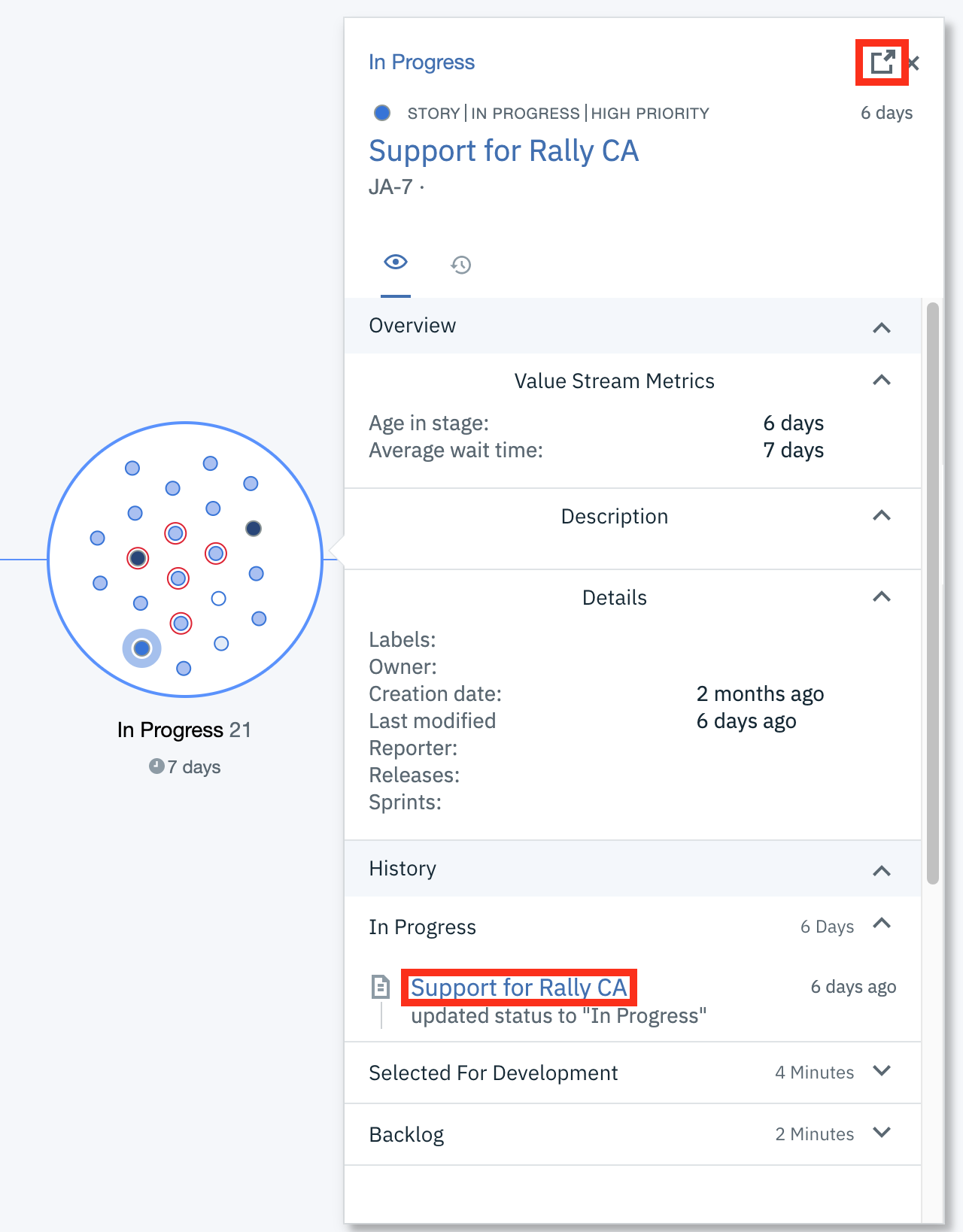Navigating value streams
Manage a value stream's displayed data by applying filters and queries.
Value stream visualization provides an overview of the value stream workflow and summary information about the individual items contained in it. The items, sometimes called dots or dots, represent objects from the tools that you use, such as builds, pull requests, issues, and tests. You use the To see objects from your integrated tools, apply filters by using the DevOps query language.
You can view value stream data in a user-focused way by using the swim lanes feature.
The highest level of a value stream is a phase. Phases contain the stages that define process flow within the phase. Stages contain data from integrated tools. Each data point is represented by an individual, graphical element. A item's position in the value stream conveys important information about the object. items in a stage named Merged, for example, can represent items merged into Git repositories. An item's shape and color convey information about the item's type and status. A item outlined in red, for example, might mean the item is past schedule. The border around a stage indicates how quickly stage items updated. When you hover the mouse over a item, the displayed card contains summary information about the item and links to associated tools.
In outline, to use a value stream, complete the following steps:
- On the HCL™ Accelerate dashboard, click Value Streams.
- On the Value streams page, select a value stream. By default, each value stream is displayed on a separate card. You can display a list of value streams instead. The value stream is displayed on the Value streams/value-stream-name page.
- Optionally, click
to display lead- and cycle-times.
- Filter the view. The items that appear on the value stream are determined by the tools that are integrated into the value stream, and queries that filter data from the integrations. Filtering options and search scope are described later in this topic.
- Optionally, click
and select Replace value stream map to modify the value stream and add queries defined in the
value-stream-name.jsonfile.
Understanding value stream data
Queries that set the value stream scope
are defined in the value-stream-name.json file. When you display a value stream,
items matching the preset queries are displayed. The following graphic displays a value stream with
items integrated from an issue tracking system and a source control system. Each stage has a query
defined for it that determines the items that are displayed in it. The In Progress stage has a query
defined for it similar to this one: "query": "issue.status=\"In Progress\" and
pr.status!=MERGED and pr.status!=closed".

In the above figure, the display can filtered by the following: Type, Priority, Release, and Sprint.
If a stage has more than 40 items, summary information replaces the individual items, as shown in the following graphic:

Value stream items
You can display information about the items in a stage. When you click an item, a card is displayed with information about the represented item, such as a Jira issue. Full history about the item is presented in context, including its history. You can use the supplied links to open the item in originating tool.
The following graphic displays a Jira issue in the value stream's In Progress stage. Links, highlighted in red in the graphic, can open the item in the integrated tool.

If linking rules are defined for the integrations, information from the linked tools and available. Link rules link two integrated tools, such as Git and Jira, to make information from both tools available in the affected items.
Value stream view by
| View value stream data by | Description |
|---|---|
| Priority | Level of importance such as low, medium, high, and so forth. |
| Release | The release versions. |
| Sprint | Sprint numbers, names, or both. |
| Type | Issue type such as story, bug, task, epic, and so forth. |

Quick filters for value stream data
At the top of the Value stream or Swim Lanes pages to the left of the Metric bar button shown above, you can use quick filters to limit the amount of value stream data that is displayed based on the selected criteria of priority, release, sprint, or type that is detailed in the above table.
- Click the View value stream data by list and select your required criteria. The color coded items associated with the selected criteria are displayed in the legend on the bottom bar.
- To further limit the display of value stream data, you can apply quick filters by clicking on
Priority, Release, Sprint, and
Type and selecting check boxes within each item in any multiple combinations
of all filters to the previously selected criteria in the bottom bar for precise narrowing of your
required data range. An example of the Priority quick filter applied with the
High and Highest criteria selected is illustrated
below.

- To remove the quick filters, either click the x to the left of any filters that were selected as shown above or individually deselect individual items within each of the criteria.
Searching the value stream
Searching a dot in value stream data is possible in two ways, Plain text
search and Search with DQL
Plain text search is the free text search of the dot in the value stream. When search text is entered in Plain text search field, it displays all dots which are associated or contains the search text. Use Plain text search field to search the dots with issue id, issue labels, issue name, issue owner, issue priority, issue types, releases, and sprints.
 .
.